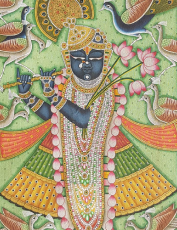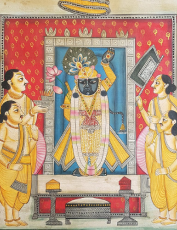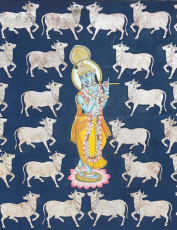Sacred Sentinel
Painting
Acrylic on canvas | 72X60in

Sacred Sentinel
Painting
Acrylic on canvas | 72X60in
Pichwai
Sacred Sentinel, which means “giving delight” or “giving joy,” is the sacred bull of the Hindu god Shiva, one of the most important Hindu gods. When the world becomes evil, Shiva destroys it to make way for beneficial change. Nandi is Shiva’s animal form, his means of transportation, and his most ardent worshiper. Shiva and Nandi's association in Hindu scriptures and art can be traced to very early Indian culture.
The white color of the bull symbolizes purity and justice. Nandi is also believed to promote enormous growth.
The lotus flower signifies purity in one's spirit for even when it is grown in the dirtiest water it is supposed to produce clean and beautiful petals. Even when we try to put water on the petal of a lotus flower the water will just roll down symbolizing freedom rather than sticking to it. The lotus flower is also defined as a symbol of "self-regeneration" or svayambhu in Sanskrit for it means existence without creation and independent. The Lotus flower has lot of religious significance in Hinduism and also in other religions like Buddhism. Lotus forms the throne of Lord Buddha which shows the roused mind of self-existent, substantive, and self-regenerating.
Pichwai




The word Pichwai has its roots in the Sanskrit pich (behind) and wai (hanging). A traditional art form that emerged in the 17th Century at the Nathdwara temple in Rajasthan, Pichwais are intricate paintings dedicated to Shrinathji and are typically hung behind the idol of the deity in local shrines. These elaborately handpainted artworks celebrate the different moods and expressions of Krishna, and mostly depict temple rituals like the adornment (hringaar) of Shrinathji according to the seasons or festivals in the Pushtimarg calendar: Janamashtami and Gopashtami, for example. A popular depiction of Krishna found in Pichwais is the Chappan Bhog (a feast of 56 delicacies) rendition as an offering to the deity. Elements of the Indian monsoon like the peacock, the lotus, and even his beloved cows are featured prominently and repeatedly.
Over time, Pichwai painting came to be practiced in various local styles. The most recognisable among these are the Nathdwara style known for its expressive portraitures, the Deccan or Hyderabadi defined by a liberal use of gold and silver leaf, the dynamic and fluid Kota-Bundi style, and the Kishangarh style inspired by Mughal miniatures.